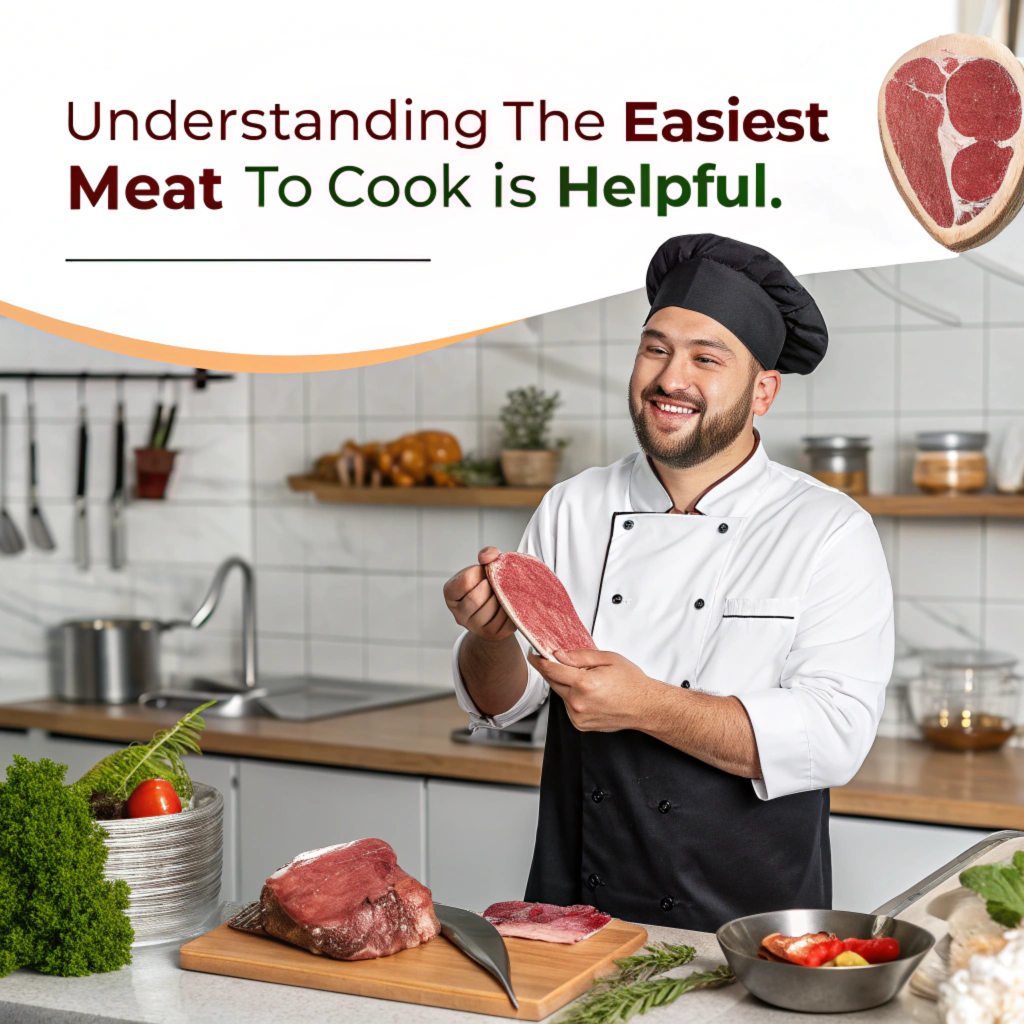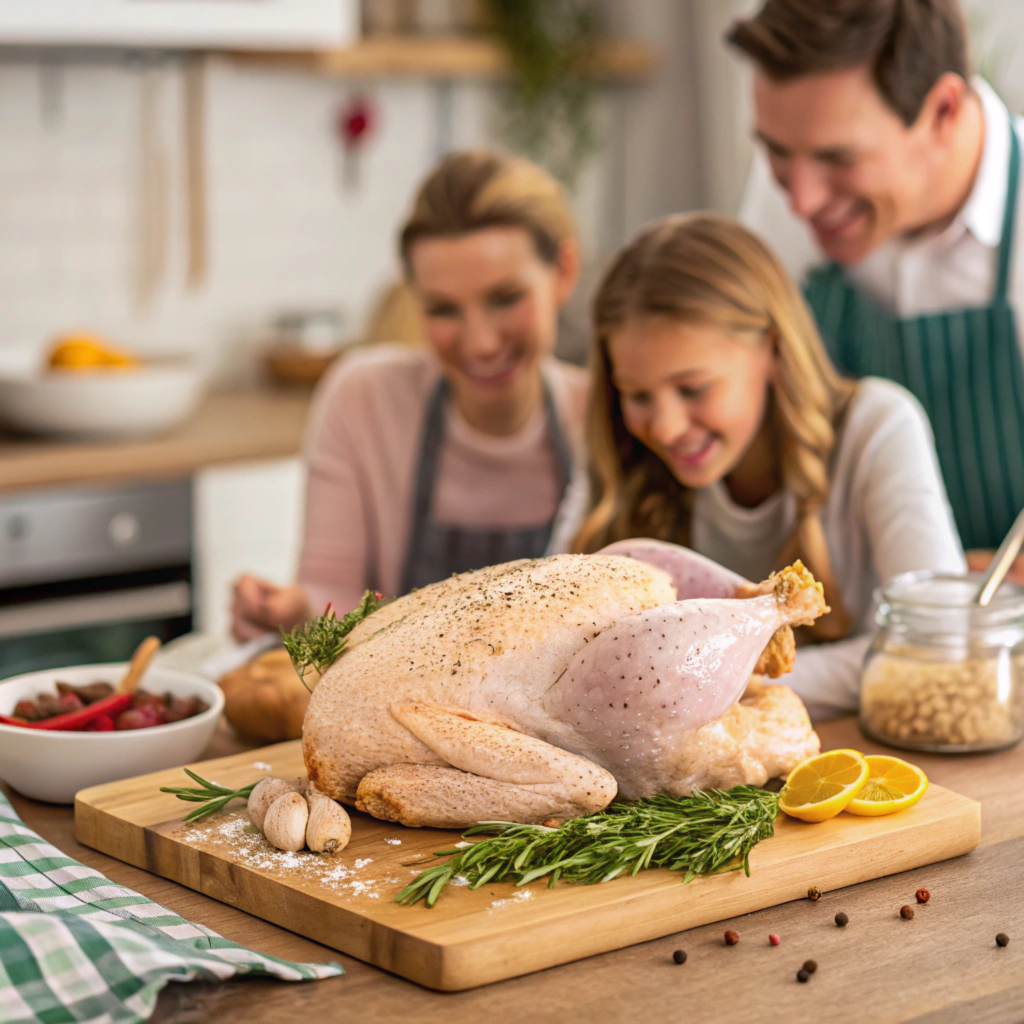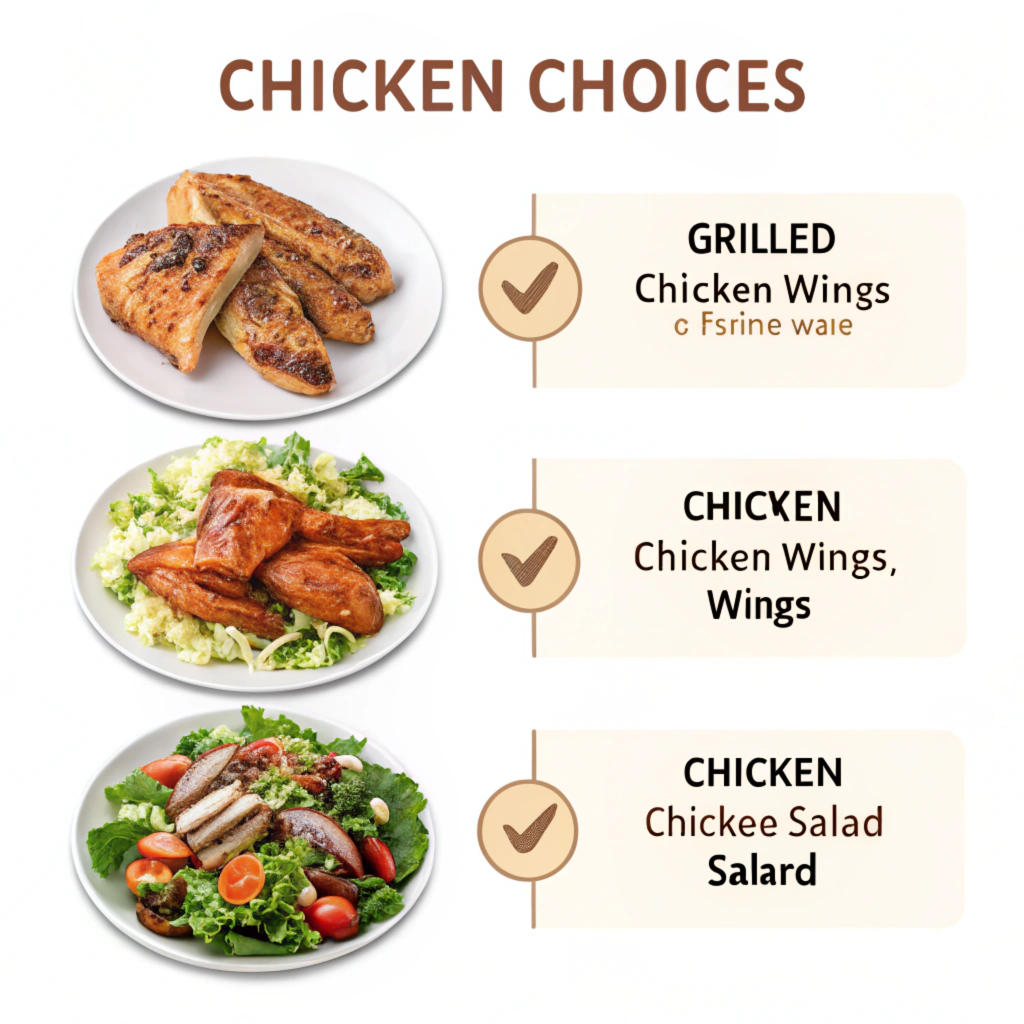
Introduction:
Many novice home cooks feel anxious when they prepare their first meat-based meals. This nervousness often arises from uncertainty about cooking times, proper seasonings, and safe internal temperatures. Choosing the easiest meat to cook helps solve these problems. When you know which proteins adapt well to simple methods, you reduce stress and gain culinary confidence. With the right starting point, you learn faster, improve your skills, and eventually tackle more complex recipes. Moreover, discovering this starting point opens the door to a wider world of flavors and techniques.
Why Choosing Simple Meats Matters for Beginners
Selecting user-friendly proteins matters because it saves time and prevents disappointment. Imagine coming home after a busy day, only to spend hours fussing over a tough cut of meat that refuses to turn tender. Instead, focus on something that cooks quickly and tastes great with minimal effort. This approach helps you enjoy cooking rather than dreading it. Additionally, it encourages experimentation since you know small mistakes will not ruin the entire dish. Soon, you realize that preparing dinner at home is not only healthier than takeout but also more satisfying, especially once you master the easiest meat to cook.
Key Factors That Make Certain Meats Simpler
Several factors influence how easy a meat is to prepare. One crucial factor is tenderness. Cuts that remain tender even if cooked slightly longer than planned make life simpler. Another factor is fat content. Moderate fat keeps meat moist, which forgives minor timing errors. Thickness also matters. Thin, uniform pieces cook evenly, helping you predict doneness without guesswork. Finally, widespread availability and plenty of easy-to-follow recipes make certain types of meat beginner-friendly. For instance, poultry, ground meats, and certain seafood choices appear in countless step-by-step tutorials.
Choosing the Right Cut for Hassle-Free Meals
Select cuts that fit your cooking style and comfort level. If you love grilling, choose small pieces that sear quickly. If you prefer roasting, pick lean cuts that reach the proper temperature in a short time. Those who enjoy slow cookers might opt for tougher cuts that turn tender with low, steady heat. Ask your butcher for advice, or consult a reliable internal resource on your site, such as, for guidance. This strategy ensures you start with the right protein and build on your successes.
Simple Chicken Choices: A Top Option for the Easiest Meat to Cook

Chicken often appears at the top of the list when discussing the easiest meat to cook. Its mild flavor matches countless seasonings, and it adapts to grilling, baking, roasting, or pan-frying. Furthermore, chicken is budget-friendly and sold in many forms, from boneless breasts to pre-cut thighs. Each option offers something unique, but all remain forgiving enough for beginners.
Chicken Breasts: Lean, Quick, and Adaptable
Chicken breasts are popular due to their lean profile and rapid cooking time. For a simple meal, season them with salt, pepper, and a drizzle of oil. Bake them in a hot oven until they reach a safe internal temperature. Flattening thick breasts into even thickness improves consistency. You can top them with a squeeze of lemon juice or a dusting of dried herbs for more flavor. Additionally, these breasts pair well with light sides like a crisp salad or roasted vegetables. Since they cook fast, they suit weeknight dinners and leave room for quick experimentation.
Chicken Thighs: Juicy and Hard to Overcook
If you fear dryness, chicken thighs solve that problem. They contain more fat, which keeps them moist. Roast them at a moderate temperature with a spice rub, and they remain tender even if left a bit longer in the oven. This flexibility makes them perfect for beginners. Chicken thighs also taste richer than breasts, holding up well to bolder seasonings like smoked paprika or mild curry blends. Serve them with rice or mashed potatoes for a comforting, foolproof meal.
Ground Meats: Some of the Easiest Options for Quick Meals
Ground meats simplify dinner because they cook fast, crumble easily, and adapt to many recipes. They represent the easiest meat to cook for those who want versatility. You can form them into patties, meatballs, or just brown them for sauces and tacos. Their speed and range make them go-to choices on busy nights.
Ground Beef: Great for Burgers and Tacos
Ground beef is familiar, widely available, and forgiving. Brown it in a hot pan, season with salt and pepper, and add your chosen spices or sauce. Turn it into a hearty taco filling by adding cumin, chili powder, and some diced onions. Shape it into burgers for a grilled feast, or simmer it in tomato sauce for an easy pasta topping. With ground beef, you master timing and seasoning without complex steps. As a result, you gain kitchen confidence.
Ground Turkey: Lean, Flavorful, and Simple
For a lighter alternative, ground turkey fits the bill. It cooks much like ground beef, yet it has less fat. This lean profile makes it healthy, although you must be careful not to overcook it. Consider adding moisture through a splash of broth or a spoonful of tomato sauce. Ground turkey suits patties, meatballs, or simple skillet meals with vegetables. After a few tries, you learn to balance flavors and create delicious results while enjoying a leaner protein choice.
Seafood Selections: Some of the Easiest Meat to Cook from the Ocean
Many people find fish and shrimp surprisingly easy. Seafood cooks fast, offers fresh flavors, and often requires little seasoning. These qualities make it excellent for novices seeking variety. With a few attempts, you will serve meals that taste like you ordered them in a restaurant, yet took only minutes to prepare at home.
Salmon Fillets: Quick Baking, Delicious Results
Salmon fillets deliver a rich, buttery taste and a moist texture. Brush them with oil, sprinkle on salt, pepper, and maybe dill, then bake at a moderate temperature. They flake easily when done, so you know when to remove them from the oven. Additionally, salmon pairs beautifully with roasted asparagus, a lemon wedge, or a light grain like quinoa. Since it cooks quickly, you can put a healthy, flavor-packed dinner on the table in less time than delivery takes.
Shrimp: Ready in Minutes, High on Flavor
Shrimp might be the ultimate easy protein. They cook so fast that overcooking is the main concern. Drop them into a hot pan with butter, garlic, and a squeeze of lemon juice. In a few minutes, they turn pink and succulent. Serve them over pasta, rice, or a green salad. Because they adapt to many seasonings, you can try Cajun spices one night and mild Italian herbs another. Their short cooking time fits hectic schedules perfectly.
Matching the Easiest Meats to Different Cooking Methods
Identifying the easiest meat to cook involves not just the protein itself, but also how you cook it. Some methods suit beginners better than others. By pairing the right method with a friendly cut, you ensure meals that taste great and reduce stress. Consider your preferred tools and available time to select the best approach.
Grilling and Roasting for Rich Flavors
Grilling and roasting rely on steady, dry heat. These methods often develop complex flavors without complicated steps. They also let you step away once the meat is in place. Just keep an eye on the timer and use a meat thermometer to confirm doneness.
Chicken Drumsticks: Great for the Grill
Chicken drumsticks handle the grill’s direct heat well. Their bone-in structure helps them stay moist. Add a simple rub of salt, pepper, and mild spices. Grill them until the skin crisps and the juices run clear. Pair them with grilled vegetables or corn on the cob. This set-it-and-forget-it approach suits casual dinners and barbecues, pleasing crowds without demanding too much from you.
Pork Tenderloin: Quick, Juicy, and Ideal for Roasting
Pork tenderloin cooks quickly and remains tender if you follow basic guidelines. Season it with a favorite herb rub, roast it at a high temperature, and remove it once the center reaches the proper temperature. After resting a few minutes, slice and serve. The mild pork flavor matches many sides, from roasted potatoes to a fresh salad. This cut helps you create elegant meals with minimal effort.
Pan-Frying and Searing: Fast Cooking with Full Control
Pan-frying and searing let you watch the cooking process up close. You can adjust heat, flip the meat, and monitor browning. This method suits thin cuts that cook fast and do not require hours of preparation. A hot pan, a bit of oil, and proper seasoning transform raw proteins into savory delights.
Steak Cuts: Ribeye or Sirloin for a Quick Sear
Ribeye and sirloin steaks may seem daunting, but they are actually straightforward. Pat them dry, season with salt and pepper, and place them in a hot skillet. Sear until a brown crust forms, then flip and finish cooking. Use a meat thermometer to guide you. Let the steak rest for a few minutes before slicing, allowing the juices to settle. Serve with a simple side, and enjoy a restaurant-quality meal at home.
Pork Chops: Simple, Satisfying, and Speedy
Boneless pork chops thrive in a hot pan. Season them, sear both sides until golden, and then finish cooking over lower heat if needed. Be mindful of timing since overcooked chops turn dry. With a bit of practice, you find the sweet spot. Accompany them with a light sauce made from the pan drippings, plus a side of roasted carrots. Suddenly, you have a complete meal prepared in minutes.
Slow-Cooking and Braising: Low, Steady Heat for Tender Results

Slow-cooking and braising suit individuals who have a bit more time and want the cooking process to be hands-off. These methods turn tougher cuts into tender, flavorful dishes without constant attention. Start the process early, and come back hours later to a finished meal.
Beef Chuck Roast: Perfect for Stews and Tender Meals
A beef chuck roast seems tough at first, but a slow cooker or dutch oven transforms it. Add broth, onions, and carrots, then let it simmer for hours. The connective tissues break down, resulting in rich flavors and a melt-in-your-mouth texture. Serve it over mashed potatoes, or shred it for tacos. In either case, you barely lifted a finger once it started cooking.
Pork Shoulder: Ideal for Braising or Stewing
Pork shoulder behaves similarly to chuck roast. Braise it with aromatic vegetables, broth, and herbs, and let it cook low and slow. Over time, it becomes fork-tender. Use it in pulled pork sandwiches, serve it with polenta, or toss it into a hearty stew. Because it requires little input once cooking begins, this method suits beginners who might feel nervous about timing shorter-cooking meats.
Practical Tips to Reduce Stress and Make Cooking Easier
By now, you understand that choosing the easiest meat to cook helps build confidence. Yet, you can simplify things further. Implementing smart cooking habits, using helpful tools, and prepping in advance make the entire process smoother.
Seasoning and Marinades for Better Flavor
Good seasoning elevates even the simplest dish. You do not need complex recipes. Salt, pepper, and one or two dried herbs can do wonders. For an even easier approach, consider pre-made spice blends. These blends combine complementary flavors without extra effort.
Use Pre-Made Spice Blends to Save Time
When you rely on pre-mixed spices, you skip measuring multiple ingredients. Sprinkle taco seasoning on ground beef, an Italian herb blend on chicken breasts, or a barbecue rub on pork chops. This shortcut helps you focus on cooking times and textures rather than complicated flavor profiles.
Marinate Overnight for Juicier Meat
Marinating meat overnight imparts more flavor and tenderness. A basic marinade includes an acid (like lemon juice), oil, and herbs or spices. The meat absorbs these elements, becoming tastier and juicier. Next day, simply remove it from the fridge, pat it dry, and cook. This approach works well for chicken thighs, pork loin, or even shrimp.
Using Kitchen Tools for Perfect Results
A few essential tools make cooking much less stressful. A meat thermometer tops the list. This handy gadget removes guesswork by telling you the exact internal temperature. For more advanced methods, consider slow cookers or air fryers. These devices allow you to achieve desired textures with minimal oversight.
Check Doneness with a Meat Thermometer
Instead of guessing, insert a thermometer into the thickest part of the meat. Compare the reading to safe temperature guidelines. This ensures juicy chicken, perfectly pink steaks, and thoroughly cooked ground meats. Once you trust the numbers, your anxiety over safety fades.
Try Slow Cookers and Air Fryers for Convenience
A slow cooker transforms tough cuts into tender meals without constant watching. An air fryer creates crispy textures using less oil and time. Both gadgets reduce the need for advanced techniques. With such support, you easily incorporate these tools into your cooking routine.
Prepping and Storing Meats for Faster Meals
Advance preparation saves time on busy nights. Buy pre-cut meats to avoid tedious slicing. Freeze portions in meal-sized amounts. With these steps, you can pull out exactly what you need, thaw it, and start cooking, cutting down on stress and waste.
Buy Pre-Cut Meats for Ease
Pre-cut chicken strips, diced beef, or peeled shrimp remove extra steps. You spend less time handling raw meat and more time cooking. This convenience matters when you want dinner fast or dislike complex prep tasks.
Freeze Small Portions for Future Use
Dividing large packages into smaller bags helps you manage serving sizes. Label each bag with the date and weight. Later, thaw just enough for one meal. This approach prevents overbuying and reduces waste. It also ensures that easy-to-cook meat is always on hand.
Easy Meats for Quick Weeknight Dinners and Meal Prep
Once you know the easiest meat to cook, you can apply this knowledge to your daily routine. Simple proteins help you whip up dinners after work or prepare large batches for the week ahead. They also support healthier eating since you control ingredients and cooking methods.
Beginner-Friendly Cuts for Busy Nights
Stick to your favorites at first. Chicken breasts and thighs, ground beef or turkey, and salmon fillets form a strong base. These options let you master timing, seasoning, and textures. As your confidence grows, experiment with new flavors or side dishes.
Family Favorites and Comfort Foods
For family meals, choose crowd-pleasers. Pork chops, chicken drumsticks, and ground beef tacos win over picky eaters. Add a hearty side like mashed potatoes or roasted vegetables, and you have a complete meal that everyone loves. With these simple proteins, you end dinnertime battles and enjoy peaceful evenings.
Healthy, Budget-Friendly Options
Cooking at home also helps your wallet. Ground turkey often costs less than other meats. Slow-cooked beef chuck roast provides multiple servings. Store leftovers and reheat them later. By selecting affordable, easy-to-cook cuts, you eat well without overspending. Plus, these proteins work well with whole grains, legumes, and fresh produce, making balanced meals accessible.
Gaining Confidence and Expanding Skills
As you continue using these tips, you will notice your confidence rising. Before long, you will know exactly when to pull that chicken breast from the oven or how long to sear a steak. You no longer depend on luck or guesswork. Instead, you develop a sense of timing and an understanding of flavor.
Small Steps Lead to Big Improvements
Each success builds on the last. Start with something simple, like chicken breasts seasoned only with salt and pepper. Once comfortable, try a new spice blend or marinade. Next, move on to salmon fillets or pork chops. Soon, you tackle recipes you never imagined attempting. By starting with the easiest meat to cook, you set yourself on a path of steady growth.
Enjoying the Culinary Journey
Cooking should be enjoyable, not stressful. When you know which meats are simplest, you relax more in the kitchen. That comfort encourages you to try new vegetables, grains, or sauces. It might even inspire you to host friends and family, confident in your ability to serve tasty meals. Eventually, cooking becomes a creative outlet rather than a chore.
Better Health, More Control, and Less Waste
Preparing meals at home also improves your health. You control the ingredients, portion sizes, and preparation methods. By focusing on lean, easy-to-cook proteins, you reduce reliance on processed foods. You also waste less since you plan portions and freeze extras. Over time, these small changes make a big difference in your well-being.
Conclusion: Finding the Easiest Meat to Cook Transforms Your Kitchen Experience
Identifying the easiest meat to cook helps you navigate the kitchen with confidence. Choosing forgiving cuts such as chicken thighs, ground beef, or salmon fillets ensures consistent results. Pairing them with suitable cooking methods like roasting or pan-searing simplifies the process. Relying on tools like thermometers, slow cookers, and pre-made spice blends removes guesswork. Prepping and freezing portions streamlines meal planning.
In the end, these simple steps allow you to enjoy cooking rather than fear it. As you gain experience, you expand your menu, try new flavors, and cook healthier meals at home. The journey begins with selecting the easiest meat to cook and ends with a happier, more skilled, and more confident home cook.